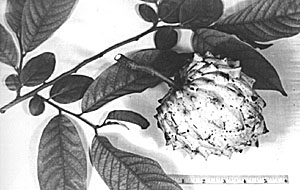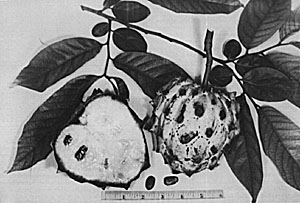From the book
Fruits of Warm Climates
by Julia F. Morton
Biribá
Rollinia mucosa
ANNONACEAE
Of the approximately 65 species of the genus Rollinia (family Annonaceae), only a few have edible fruit and the best-known is the biribá, R. mucosa Baill. (syns. R. orthopetala A. DC.; Annona mucosa Jacq.; A. sieberi A. DC.; and possibly R. deliciosa
Safford?). The popular Brazilian name has been widely adopted, but in
that country it may also be called biribá de Pernambuco, fruta da
condessa, jaca de pobre, araticu, araticum, araticum pitaya. In Peru,
it is anon; in Ecuador, chirimoya; in Colombia, mulato; in Venezuela,
rinon or rinon de monte; in Mexico, anona babosa or zambo. In Trinidad
it is called wild sugar apple; in Guadeloupe, cachiman morveux,
cachiman cochon or cachiman montagne, in Puerto Rico, cachiman or anon
cimarron, in the Dominican Republic, candongo or anona.
Description
This
fast-growing tree ranges from 13 to 50 ft (4-15 m) in height; has
brown, hairy twigs and alternate, deciduous, oblong-elliptic or
ovate-oblong leaves, pointed at the apex, rounded at the base, 4 to 10
in (10-25 cm) long, thin but somewhat leathery and hairy on the
underside. The flowers, borne 1 to 3 or occasionally more together in
the leaf axils, are hermaphroditic, 3/4 to 1 3/8 in (23.5 cm) wide;
triangular, with 3 hairy sepals, 3 large, fleshy outer petals with
upturned or horizontal wings, and 3 rudimentary inner petals. The fruit
is conical to heart-shaped, or oblate; to 6 in (15 cm) in diameter; the
rind yellow and composed of more or less hexagonal, conical segments,
each tipped with a wart-like protrusion; nearly 1/8 in (3 mm) thick,
leathery, tough and indehiscent. The pulp is white, mucilaginous,
translucent, juicy, subacid to sweet. There is a slender, opaque-white
core and numerous dark-brown, elliptic or obovate seeds 5/8 to 3/4 in
(1.6-2 cm) long.
Origin and Distribution
This
species has an extensive natural range, from Peru and northern
Argentina, Paraguay and Brazil and northward to Guyana, Venezuela,
Colombia and southern Mexico; Trinidad, the Lesser Antilles including
Guadeloupe, Martinique and St. Vincent; and Puerto Rico and Hispaniola.
It is much cultivated around Iquitos, Peru, and Rio de Janeiro, Brazil
and the fruits are marketed in abundance. It is the favorite fruit in
western Amazonia.
Seeds were first introduced into the United
States from Para, Brazil, by O.W. Barrett in 1908 (S.P.I. #22512); a
second time from Parain 1910 (S.P.I. #27579) and again in 1912 (S.P.I.
#27609). The United States Department of Agriculture received seeds
from Rio de Janeiro in 1914 (S.P.I. #38171). P.J. Wester may have taken
seeds to the Philippines where the species first fruited in 1915.
Seedlings were distributed to pioneers in southern Florida but only a
very few trees exist here today.

Fig. 26: The biriba (Rollinia mucosa) is an attractive light-yellow at first.
Varieties
The
only named selection referred to in the literature is 'Regnard'
reported by P.J. Wester in 1917 as the best variety introduced into the
Philippines. A form in the western Amazon region has very pronounced
points; weighs up to 8.8 lbs (4 kg).
Pollination
Brazilian
scientists have found that 4 species of beetles of the family
Chrysomelidae pollinate the flowers, but only 32% of the blooms set
fruit. Fruiting begins 55 days after the onset of flowering.
Climate and Soil
The
biribá is limited to warm lowlands, from 20° north to 30° south
latitudes in tropical America. In Puerto Rico, it occurs at elevations
between 500 and 2,000 ft (150-600 m). It has succumbed to temperature
drops to 26.5°F (-3.10°C) in southern Florida. In Brazil, the tree
grows naturally in low areas along the Amazon subject to periodic
flooding and it was expected to do well in the Florida Everglades. In
the Philippines it is said to flourish where the rainfall is equally
distributed throughout the year. Calcareous soils do not seem to be
unsuitable in Florida or Puerto Rico as long as they are moist.

Fig. 27: Handling causes the conical projections on the fruit to turn black.
Season and Harvesting
In
Amazonia, the tree may flower and fruit off and on during the year but
the fruits are most abundant from January to June. The fruits ripen in
February and March in Rio de Janeiro. In Florida, fruits have matured
in November and December. In South America, the fruit is picked when
still green and hard in order to transport it intact to urban markets
where it gradually turns yellow and soft. When the fruit is fully ripe,
handling causes the wart-like protuberances on the rind to turn brown
or near-black, rendering it unattractive.
Pests and Diseases
The most important pests in Brazil are the larvae of Cerconota anonella (Lepidopterae) which attack fruits in the process of maturing. The borer, Cratosomus bombina, penetrates the bark and trunk. A stinging caterpillar, Sabine sp., feeds on the leaves. A white fly, Aleurodicus cocois, attacks foliage of young and adult plants. Pseudococcus brevipes and Aspidiotus destructor are found on the leaves and sometimes on the fruits. Black spots on the leaves are caused by the fungus Cercospora anonae. Glomerella cingulata causes dieback and fruit rot in Florida.
| Food
Value Per
100 g of Edible Portion* |
| Calories
|
80 |
| Moisture
|
77.2 g |
| Protein |
2.8 g |
| Lipids |
0.2 g |
| Glycerides |
1.3 g |
| Fiber |
1.3 g |
| Ash |
0.7 g |
| Calciium | 24 mg |
| Phosphorus |
26 mg |
| Iron |
1.2 mg |
| Vitamin B1 |
0.04 mg |
| Vitamin B2 | 0.04 mg | | Niacin | 0.5 mg | | Ascorbic Acid | 3.0 mg | | | | Amino Acids (mg per g of Nitrogen (N = 6.25): | | | | Lysine | 316 mg | | Methionine | 178 mg | | Threonine | 219 mg | | Tryptophan | | | |
| *According
to Brazilian analyses |
|
Food Uses
The fruit is eaten fresh and is fermented to make wine in Brazil.
Other Uses
The wood of the tree is yellow, hard, heavy, strong and is used for ribs for canoes, boat masts, boards and boxes.
Medicinal Uses:
The fruit is regarded as refrigerant, analeptic and antiscorbutic. The
powdered seeds are said to be a remedy for enterocolitis.
|
|